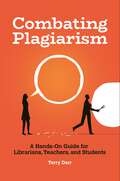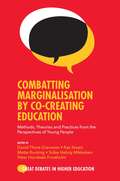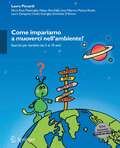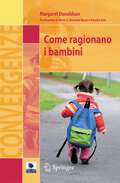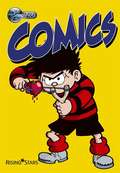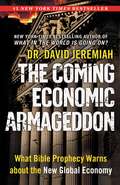- Table View
- List View
Combating Plagiarism: A Hands-On Guide for Librarians, Teachers, and Students
by Terry DarrOffers an instructional plan for plagiarism education for middle school and high school students, allowing librarians to become a resource for students, teachers, and school administrators.The proliferation of resources now available through libraries and the internet requires a new set of information management skills in order for students to avoid plagiarism. While educators legitimately expect students to approach academic work with honesty and integrity, students need to be able to understand the context of their academic resources—both print and digital—well enough to use them appropriately and ethically. Combating Plagiarism helps middle and high school teachers and librarians understand and teach the authorship and publication process so students learn to use relevant information in an ethically and academically sound fashion.Terry Darr's long-term collaboration with a high school history teacher taught her the challenges faced by students conducting research—and by librarians and teachers tasked with teaching plagiarism prevention. Her book is full of tested concepts for teaching these complex topics, emphasizing our modern reliance on digital sources. An extensive student reference section covers common knowledge, fact, and opinion. A wealth of practical resources includes real-life examples from research papers as well as plenty of instructional materials, exercises, and lesson plans.
Combating Plagiarism: A Hands-On Guide for Librarians, Teachers, and Students
by Terry DarrOffers an instructional plan for plagiarism education for middle school and high school students, allowing librarians to become a resource for students, teachers, and school administrators.The proliferation of resources now available through libraries and the internet requires a new set of information management skills in order for students to avoid plagiarism. While educators legitimately expect students to approach academic work with honesty and integrity, students need to be able to understand the context of their academic resources—both print and digital—well enough to use them appropriately and ethically. Combating Plagiarism helps middle and high school teachers and librarians understand and teach the authorship and publication process so students learn to use relevant information in an ethically and academically sound fashion.Terry Darr's long-term collaboration with a high school history teacher taught her the challenges faced by students conducting research—and by librarians and teachers tasked with teaching plagiarism prevention. Her book is full of tested concepts for teaching these complex topics, emphasizing our modern reliance on digital sources. An extensive student reference section covers common knowledge, fact, and opinion. A wealth of practical resources includes real-life examples from research papers as well as plenty of instructional materials, exercises, and lesson plans.
Combating Social Exclusion in University Adult Education (Routledge Revivals)
by Julia PreecePublished in 1999, this work suggests that widening participation is not just about changing learner expectations; it is also about changing institutional expectations and practices. "Higher" learning, for example, should include a broader, more inclusive range of knowledge and ways of knowing than at present and criteria for learning achievement should include assessment of "citizenship" as well as linear outcomes.
Combating Social Exclusion in University Adult Education (Routledge Revivals)
by Julia PreecePublished in 1999, this work suggests that widening participation is not just about changing learner expectations; it is also about changing institutional expectations and practices. "Higher" learning, for example, should include a broader, more inclusive range of knowledge and ways of knowing than at present and criteria for learning achievement should include assessment of "citizenship" as well as linear outcomes.
Combatting Marginalisation by Co-Creating Education: Methods, Theories and Practices from the Perspectives of Young People (Great Debates in Higher Education)
by David Thore Gravesen, Kaz Stuart, Mette Bunting, Sidse Hølvig Mikkelsen, Peter Hornbæk FrostholmThe result of collaboration between students and researchers across Europe as part of an Erasmus+ funded project, this book sheds light on power structures and exclusion processes in education from the perspectives of young people. Bridging practical, empirical and theoretical questions, and focusing on young people’s stories in and outside of school, this edited collection delves into the narratives of young respondents that have experienced severe challenges in their school life. Written in three parts, the authors introduce the basic concepts surrounding social inclusion and equality, present chapters written and co-written with students, and consider the implications and models for practice, both in schools, youth work and higher education. Including a final chapter written by guest author Distinguished Professor Michelle Fine, who reflects on the project, and the potentials for future education, youth work and research, this book invites readers to better understand marginalization and how to build an inclusive educational future.
Combatting Marginalisation by Co-Creating Education: Methods, Theories and Practices from the Perspectives of Young People (Great Debates in Higher Education)
by David Thore Gravesen Kaz Stuart Mette Bunting Sidse Hølvig Mikkelsen Peter Hornbæk FrostholmThe result of collaboration between students and researchers across Europe as part of an Erasmus+ funded project, this book sheds light on power structures and exclusion processes in education from the perspectives of young people. Bridging practical, empirical and theoretical questions, and focusing on young people’s stories in and outside of school, this edited collection delves into the narratives of young respondents that have experienced severe challenges in their school life. Written in three parts, the authors introduce the basic concepts surrounding social inclusion and equality, present chapters written and co-written with students, and consider the implications and models for practice, both in schools, youth work and higher education. Including a final chapter written by guest author Distinguished Professor Michelle Fine, who reflects on the project, and the potentials for future education, youth work and research, this book invites readers to better understand marginalization and how to build an inclusive educational future.
Combinatorics and Reasoning: Representing, Justifying and Building Isomorphisms (Mathematics Education Library #47)
by Carolyn A. Maher Arthur B. Powell Elizabeth B. UptegroveCombinatorics and Reasoning: Representing, Justifying and Building Isomorphisms is based on the accomplishments of a cohort group of learners from first grade through high school and beyond, concentrating on their work on a set of combinatorics tasks. By studying these students, the editors gain insight into the foundations of proof building, the tools and environments necessary to make connections, activities to extend and generalize combinatoric learning, and even explore implications of this learning on the undergraduate level. This volume underscores the power of attending to basic ideas in building arguments; it shows the importance of providing opportunities for the co-construction of knowledge by groups of learners; and it demonstrates the value of careful construction of appropriate tasks. Moreover, it documents how reasoning that takes the form of proof evolves with young children and discusses the conditions for supporting student reasoning.
Combinatorics and Reasoning: Representing, Justifying and Building Isomorphisms (Mathematics Education Library #47)
by Elizabeth B. Uptegrove Carolyn A. Maher Arthur B. PowellCombinatorics and Reasoning: Representing, Justifying and Building Isomorphisms is based on the accomplishments of a cohort group of learners from first grade through high school and beyond, concentrating on their work on a set of combinatorics tasks. By studying these students, the editors gain insight into the foundations of proof building, the tools and environments necessary to make connections, activities to extend and generalize combinatoric learning, and even explore implications of this learning on the undergraduate level. This volume underscores the power of attending to basic ideas in building arguments; it shows the importance of providing opportunities for the co-construction of knowledge by groups of learners; and it demonstrates the value of careful construction of appropriate tasks. Moreover, it documents how reasoning that takes the form of proof evolves with young children and discusses the conditions for supporting student reasoning.
Combining Methods in Educational Research (UK Higher Education OUP Humanities & Social Sciences Education OUP)
by Stephen Gorard Chris Taylor“This excellent book promises much and delivers a whole lot more. It provides a description of the practicalities of combining evidence from a variety of data collection modes in order to enrich our responses to educational research questions. This is achieved with thoroughness and clarity and even some wit. There are outstanding teaching materials here…. This is the best book on educational research methods published in this country for decades.” Professor Charles Desforges, University of Exeter "In this timely and important contribution, Stephen Gorard and Chris Taylor help us move beyond the wasteful schism of 'qualitative versus quantitative' research by offering sound basic theorising and extensive practical illustration of the combining of research methods... I see their book as essential reading for anyone concerned for effective educational and social research."Professor Peter Tomlinson, University of LeedsThere is growing interest in the possibilities of combining research approaches in education and social sciences, as dissatisfaction mounts with the limitations of traditional mono-method studies and with the schism between quantitative and qualitative methods. This book argues the case for combining multiple research methods, and provides much-needed practical guidance for researchers who want to use this mixed-methods approach. The authors believe that all research has an over-arching logic and that, within this, the fruitful combination of quantitative and qualitative methods is possible. They develop the idea of the ‘new’ education and social researcher, for whom the combination of approaches is a representation of a diverse skills base, rather than a matter of ideological or theoretical allegiance.The book outlines and evaluates methods that are currently used, and looks at combining different methods across and within studies, including complex interventions, Bayesian approaches, new political arithmetic, triangulation, life histories and design studies. It offers a radical, new and very simple way of working with numbers.Drawing on examples across the social sciences, this book is key reading for undergraduate and postgraduate students in Education and social science courses with a research element, as well as academics and professionals undertaking research projects.
Come Alive!: (PDF)
by Sister Corita Kent Julie Ault Daniel BerriganAdmired by Charles and Ray Eames, Buckminster Fuller and Saul Bass, Sister Corita Kent (1918–1986) was one of the most innovative and unusual pop artists of the 1960s, battling the political and religious establishments, revolutionizing graphic design and encouraging the creativity of thousands of people – all while living and practising as a Catholic nun in California. Mixing advertising slogans and poetry in her prints and commandeering nuns and students to help make ambitious installations, processions and banners, Sister Corita's work is now recognized as some of the most striking – and joyful – American art of the 60s. But, at the end of the decade and at the height of her fame and prodigious work rate, she left the convent where she had spent her adult life. Julie Ault's book is the first to examine Corita's life and career.
Come Alive!: The Spirited Art Of Sister Corita
by Sister Corita Kent Julie Ault Daniel BerriganAdmired by Charles and Ray Eames, Buckminster Fuller and Saul Bass, Sister Corita Kent (1918–1986) was one of the most innovative and unusual pop artists of the 1960s, battling the political and religious establishments, revolutionizing graphic design and encouraging the creativity of thousands of people – all while living and practising as a Catholic nun in California. Mixing advertising slogans and poetry in her prints and commandeering nuns and students to help make ambitious installations, processions and banners, Sister Corita's work is now recognized as some of the most striking – and joyful – American art of the 60s. But, at the end of the decade and at the height of her fame and prodigious work rate, she left the convent where she had spent her adult life. Julie Ault's book is the first to examine Corita's life and career.
Come and Sail with Me (Rigby Star Independent #Pink Level)
by Lisa ThompsonHow many gold coins will the Captain give for each barrel? Meet Captain Red Beard, Bones the sea dog, Fingers the parrot and the rest of the sea-loving pirate crew aboard their ship the Black Beast. The Pirate Cove series is expertly levelled to Book Bands ensuring that every independent reading session is successful in helping to turn children into confident and enthusiastic readers. There are also clear parent notes inside every book to support parents reading at home with their children.
Come and Sail with Me (Rigby Star Independent #Pink Level)
by Lisa ThompsonHow many gold coins will the Captain give for each barrel? Meet Captain Red Beard, Bones the sea dog, Fingers the parrot and the rest of the sea-loving pirate crew aboard their ship the Black Beast. The Pirate Cove series is expertly levelled to Book Bands ensuring that every independent reading session is successful in helping to turn children into confident and enthusiastic readers. There are also clear parent notes inside every book to support parents reading at home with their children.
Come impariamo a muoverci nell'ambiente?: Esercizi per bambini dai 5 ai 10 anni
by Maria Rosa Pizzamiglio Filippo Bianchini Liana Palermo Monica Risetti Laura Zompanti Cecilia Guariglia Simonetta D'AmicoL’esperienza mediante esplorazione e la familiarità con l’ambiente migliorano la capacità di muoversi competentemente nel mondo. Questo libro intende potenziare il senso dell’orientamento fin dalla prima infanzia, proponendo esercizi eseguibili a scuola e a casa. La prima parte illustra le teorie sulla capacità navigazionale e sull’acquisizione di tale competenza, seguita da un’indagine sperimentale condotta su bambini di 4-7 anni per indagare lo sviluppo di differenti tipi di memoria implicati nell’orientamento. La seconda parte ha come protagonista un piccolo alieno “Kosmos” che si è perso sul nostro pianeta e ha bisogno di aiuto per imparare ad usare i prerequisiti di percezione visuo-spaziale, il linguaggio spaziale, la memoria di posizioni nell’ambiente, le rotazioni mentali e il riconoscimento di luoghi e oggetti da diverse prospettive. I bambini dovranno inoltre aiutare Kosmos a consultare delle mappe e a riprodurre dei percorsi all’interno di un ambiente virtuale.
Come on Dad!: Let's Go On Holiday! (Start Reading: Let's Go on Holiday!)
by Louise JohnThe family are on holiday. Mum, Olly and Cara want to climb to the top of the very steep hill, but when they do where is Dad?
Come ragionano i bambini (Convergenze)
by Margaret DonaldsonIl libro Children’s Minds esce nel 1978. Con un linguaggio semplice, ma supportato da dati di ricerche condotte con rigore metodologico, Margaret Donaldson attacca molti luoghi comuni ispirati alle teorie di Piaget. Come sostiene l’autrice "Nello svolgimento di questo libro, io sostengo che oggi esistono prove che ci costringono a respingere certi aspetti della teoria di Jean Piaget sullo sviluppo intellettuale". Il libro fu quasi subito tradotto in italiano e pubblicato da EMME Edizioni, ma uscì dal commercio molto rapidamente e non fu ristampato. Su questo testo hanno lavorato molti ricercatori nei campi che vanno dalla psicologia cognitiva alla pedagogia alla didattica. Lo stile del libro e la sua scorrevolezza ne fanno in realtà una lettura adatta a un pubblico più vasto. In particolare sono molti gli stimoli e le indicazioni che un insegnante vi può trovare, anche se forse questo testo non ha influenzato tanto quanto avrebbe meritato i sistemi di convinzioni e le pratiche didattiche, almeno in Italia. Molti degli esempi discussi dalla Donaldson riguardano la costruzione dei primi significati matematici (la quantità, il coordinamento dei punti di vista, ecc.), o aspetti trasversali importanti per l’apprendimento della matematica, quali il ruolo del linguaggio e l’attività di soluzione di problemi. Per rendere più espliciti i riferimenti e le implicazioni per l’insegnamento della matematica il testo è accompagnato da una postfazione di Maria G. Bartolini Bussi e Rosetta Zan, che illustrano sia alcuni sviluppi successivi dei temi trattati che alcuni esempi di applicazioni a ricerche sperimentali in didattica della matematica.
Comets (Trailblazers Ser.)
by David OrmeComets investigates topics such as 'Meterorites from Mars' and the end of the dinosaurs. In the science fiction story 'Doom from Space' planet Earth is threatened by a massive comet.
Comic Art, Creativity and the Law (Elgar Law and Entrepreneurship series)
by Marc H. GreenbergGraphic novels and comics have launched characters and stories that play a dominant role in contemporary popular culture throughout the world. The extensive revisions in this second edition of Comic Art, Creativity and the Law update the author’s analysis of important changes at the intersection of law and comics, featuring an examination of how recent cases will affect the creative process as applied to comic art.Throughout, Marc H. Greenberg examines the impact of contract law, copyright law (including termination rights, parody and ownership of characters), tax law and obscenity law on the creative process. He considers how these laws enhance and constrain the process of creating comic art by examining the effect their often inconsistent and incoherent application has had on the lives of creators, retailers and readers of comic art. Thoroughly revised and updated, there are new chapters featuring a discussion of important new cases in copyright work-for-hire and fair use doctrines; the intersection of law and fan-based creations, such as fan fiction, fan art, fan film and cosplay; as well as a new chapter on licensing comics for motion pictures and television.Designed for academics, practitioners, students of law and fans of comic art, the book offers proposals for changes in those laws that constrain the creative process, as well as a glimpse into the future of comic art and the law.
Comic Book Collections for Libraries
by Bryan D. Fagan Jody Condit FaganThis book will help librarians extend literary graphic novel collections to attract a large, untapped group of comic book readers with a sure-to-be-popular comic book collection.Do comic books belong in libraries? Absolutely—as Comic Book Collections for Libraries makes very clear. This illustrated guide defines the role of comic books in the modern library, provides a thorough grounding in the subject for beginners, and suggests new ideas for those already familiar with these perennial reader favorites. The book begins by introducing the structure of the comic book, industry players, and genres. The bulk of the guide, however, is comprised of actionable advice on such things as creating and maintaining the collection, cataloging for effective access, and promoting the collection, including how to feature comics with other library materials, such as movies and games. Drawing on the authors' experience, the volume answers numerous other questions as well. How can you tell which titles are age-appropriate for your library? Which titles are popular? How do you include characters that will appeal to diverse reader groups? Complete with checklists and a rich array of examples, this easy-to-use work can make every librarian a superhero.
Comics: im Medienmarkt, in der Analyse, im Unterricht (Schriftenreihe des Institut Jugend Film Fernsehen #1)
by Fuchs Wolfgang J.Comics (PDF)
by Roger HurnThis series of books incorporates popular themes combined with a low reading age to entice reluctant students back to reading.
The Coming Economic Armageddon: What Bible Prophecy Warns about the New Global Economy
by Dr. David JeremiahNever before have we read such jarring headlines, distressing news analyses, or dire predictions concerning the world's financial future. The American housing market -- or, more sentimentally, the American dream -- began to collapse in 2006, taking with it large chunks of the global financial system. Millions of jobs worldwide have vanished forever. Did Bible prophecy predict this catastrophe? Are there biblical clues to how soon, if ever, a viable, long-term recovery can be sustained? Is the financial collapse just one of several signs that we are living in the final days of Earth's history In THE COMING ECONOMIC ARMAGEDDON, David Jeremiah says we can know the meaning behind what we see in the daily news -- and understand and prepare for living in the New Global Economy.
Coming in from the Margins: Faculty Development’s Emerging Organizational Development Role in Institutional Change
by Connie SchroederWhy is it critical for faculty development centers to reexamine their core mission today?The core argument of this book – that a necessary and significant role change is underway in faculty development – is a call for centers to merge the traditional responsibilities and services of the past several decades with a leadership role as organizational developers. Failing collectively to define and outline the dimensions and expertise of this new role puts centers at risk of not only marginalization, but of dissolution. When a TLC is busy and in demand, it is hard to believe that it may be, despite all the activity and palpable array of daily outcomes, institutionally marginalized. The actual and increasing potential of marginalization and center closings may help motivate this field to recognize the danger of complacency or remaining stuck in an old paradigm that exclusively defines itself as instructional development or supportive service. Proposing a newly defined organizational development role for academic and faculty developers and directors of teaching and learning centers, Coming in from the Margins examines how significant involvement in broader institutional change initiatives is becoming a critical aspect of this work. Although undefined and unrecognized as a significant dimension of this work, the organizational development role increasingly demanded of developers is far more attuned with the demand for change facing higher education than ever before. The book provides evidence-based research into what directors of centers are currently doing as organizational developers, and how they shape, influence, and plan institutional initiatives that intersect with teaching and learning. Directors of centers, their supervisors, and leaders in the field provide models, from a wide range of institutional contexts, as well as the strategies they have employed to successfully engage in significant organizational development. They also demonstrate how they handled the challenges that ensued. The strategies in each chapter provide a practical resource and guide for re-examining the mission and structure of existing centers, or for designing new centers of teaching and learning and, most importantly, to develop their role as change agents.The book covers such topics as: Center mission statements; Center staffing; Center advisory boards; committee involvement; unique expertise, knowledge and skills; embedding Centers in strategic planning; Center vision; organizational change processes; collaboration and partnerships; institutional priorities and initiatives; relationships with upper administration.
Coming in from the Margins: Faculty Development’s Emerging Organizational Development Role in Institutional Change
by Connie SchroederWhy is it critical for faculty development centers to reexamine their core mission today?The core argument of this book – that a necessary and significant role change is underway in faculty development – is a call for centers to merge the traditional responsibilities and services of the past several decades with a leadership role as organizational developers. Failing collectively to define and outline the dimensions and expertise of this new role puts centers at risk of not only marginalization, but of dissolution. When a TLC is busy and in demand, it is hard to believe that it may be, despite all the activity and palpable array of daily outcomes, institutionally marginalized. The actual and increasing potential of marginalization and center closings may help motivate this field to recognize the danger of complacency or remaining stuck in an old paradigm that exclusively defines itself as instructional development or supportive service. Proposing a newly defined organizational development role for academic and faculty developers and directors of teaching and learning centers, Coming in from the Margins examines how significant involvement in broader institutional change initiatives is becoming a critical aspect of this work. Although undefined and unrecognized as a significant dimension of this work, the organizational development role increasingly demanded of developers is far more attuned with the demand for change facing higher education than ever before. The book provides evidence-based research into what directors of centers are currently doing as organizational developers, and how they shape, influence, and plan institutional initiatives that intersect with teaching and learning. Directors of centers, their supervisors, and leaders in the field provide models, from a wide range of institutional contexts, as well as the strategies they have employed to successfully engage in significant organizational development. They also demonstrate how they handled the challenges that ensued. The strategies in each chapter provide a practical resource and guide for re-examining the mission and structure of existing centers, or for designing new centers of teaching and learning and, most importantly, to develop their role as change agents.The book covers such topics as: Center mission statements; Center staffing; Center advisory boards; committee involvement; unique expertise, knowledge and skills; embedding Centers in strategic planning; Center vision; organizational change processes; collaboration and partnerships; institutional priorities and initiatives; relationships with upper administration.
Coming of Age in Academe: Rekindling Women's Hopes and Reforming the Academy
by Jane Roland MartinFirst Published in 2000. Routledge is an imprint of Taylor & Francis, an informa company.
